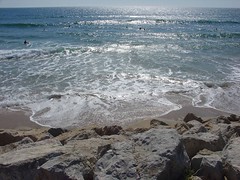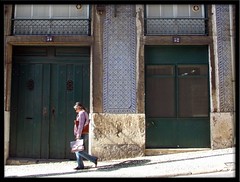An Email From My Mom
A couple of days ago, my mom sent me an email that has relevance over the recent disaster in New Orleans. This is an article written in November of 2004, published after Hurricane Ivan and before Katrina wreacked havoc. It's scary how accurate it truly is.
Natural Hazards Observer Vol. XXIX No. 2 November 2004
Disasters Waiting to Happen . . . Sixth in a Series
What if Hurricane Ivan Had NotMissed New Orleans?
Author’s Note: This column was originally intended to be the final disaster in the “Disasters Waiting to Happen” series. As I was developing the hypothetical situation depicting a devastating hurricane striking New Orleans, Louisiana, the disaster waiting to happen threatened to become a reality: Hurricane Ivan, a category 4 hurricane (with 140 mph winds) fluctuating to a category 5 (up to 155 mph winds), was slowly moving directly toward New Orleans. Forecasters were predicting a one-in-four chance that Ivan would remain on this direct path and would be an “extreme storm” at landfall. In reality, the storm veered to the north and made landfall east of Mobile Bay, Alabama, causing devastation and destruction well into the central Gulf shoreline and throughout the Southeast and the Mid-Atlantic states.
What if Ivan Had Hit New Orleans?
New Orleans was spared, this time, but had it not been, Hurricane Ivan would have:
- Pushed a 17-foot storm surge into Lake Pontchartrain;
- Caused the levees between the lake and the city to overtop and fill the city “bowl” with water from lake levee to river levee, in some places as deep as 20 feet;
- Flooded the north shore suburbs of Lake Pontchartrain with waters pushing as much as seven miles inland; and
- Inundated inhabited areas south of the Mississippi River.
Evacuation Challenges
Researchers have estimated that prior to a “big one,” approximately 700,000 residents of the greater New Orleans area (out of 1.2 million) would evacuate. In the case of Hurricane Ivan, officials estimate that up to 600,000 evacuated from metropolitan New Orleans between daybreak on Monday, September 13 and noon on Wednesday, September 15, when the storm turned and major roads finally started to clear.
To aid in the evacuation, transportation officials instituted contraflow evacuation for the first time in the area’s history whereby both lanes of a 12-mile stretch of Interstate 10 were used to facilitate the significantly increased outbound flow of traffic toward the northwest and Baton Rouge. The distance of the contraflow was limited due to state police concerns about the need for staff to close the exits. And, although officials were initially pleased with the results, evacuees felt the short distance merely shifted the location of the major jams.
These feelings were justified by the amount of time it took residents to evacuate—up to 11 hours to go the distance usually traveled in less than 1.5. For many who evacuated into Texas, total evacuation time frequently exceeded 20 hours. Since the storm, a consensus has developed that to alleviate this congestion much more secondary highway coordination is necessary throughout the state, contraflow needs to be considered for much greater distances, residents who are able and willing to evacuate early must be doubly encouraged to do so, families with multiple cars need to be discouraged from taking more than one unless they are needed to accommodate evacuees, and all modes of transportation in their various configurations must be fully considered for the contributions they can make to a safe and effective evacuation.
The major challenge to evacuation is the extremely limited number of evacuation routes, which is the result of the same topography and hydrology responsible for the area’s high level of hurricane risk. The presence of the Mississippi River, several lakes and bays, and associated marshes and swamps necessitates very expensive roadway construction techniques that are generally destructive to the environment, making the addition of more arteries increasingly challenging. This problem of limited evacuation routes also plagues the rest of the delta plain of southeast and south central Louisiana.
The fact that 600,000 residents evacuated means an equal number did not. Recent evacuation surveys show that two thirds of nonevacuees with the means to evacuate chose not to leave because they felt safe in their homes. Other nonevacuees with means relied on a cultural tradition of not leaving or were discouraged by negative experiences with past evacuations.
For those without means, the medically challenged, residents without personal transportation, and the homeless, evacuation requires significant assistance. The medically challenged often rely on life support equipment and are in such fragile states of health that they can only be moved short distances to medically equipped shelters. While a large storm-resistant structure with appropriate equipment has yet to be constructed or retrofitted, the Superdome was used to shelter nonevacuees during Ivan.
Residents who did not have personal transportation were unable to evacuate even if they wanted to. Approximately 120,000 residents (51,000 housing units x 2.4 persons/unit) do not have cars. A proposal made after the evacuation for Hurricane Georges to use public transit buses to assist in their evacuation out of the city was not implemented for Ivan. If Ivan had struck New Orleans directly it is estimated that 40-60,000 residents of the area would have perished.
Unwilling to merely accept this reality, emergency managers and representatives of nongovernmental disaster organizations, local universities, and faith based organizations have formed a working group to engage additional faith-based organizations in developing ride-sharing programs between congregation members with cars and those without. In the wake of Ivan’s near miss, this faith-based initiative has become a catalyst in the movement to make evacuation assistance for marginalized groups (those without means of evacuation) a top priority for all levels of government.
To the Rescue
If a hurricane of a magnitude similar to Ivan does strike New Orleans, the challenges surrounding rescue efforts for those who have not evacuated will be different from other coastal areas. Rescue teams would have to don special breathing equipment to protect themselves from floodwaters contaminated with chemicals and toxins released from commercial sources within the city and the petrochemical plants that dot the river’s edge. Additionally, tank cars carrying hazardous materials, which constantly pass through the city, would likely be damaged, leaking their contents into the floodwater and adding to the “brew.” The floodwater could become so polluted that the Environmental Protection Agency might consider it to be hazardous waste and prohibit it from being pumped out of the leveed areas into the lake and marshes until treated.
Regional and national rescue resources would have to respond as rapidly as possible and would require augmentation by local private vessels (assuming some survived). And, even with this help, federal and state governments have estimated that it would take 10 days to rescue all those stranded within the city. No shelters within the city would be free of risk from rising water. Because of this threat, the American Red Cross will not open shelters in New Orleans during hurricanes greater than category 2; staffing them would put employees and volunteers at risk. For Ivan, only the Superdome was made available as a refuge of last resort for the medically challenged and the homeless.
The Aftermath
In this hypothetical storm scenario, it is estimated that it would take nine weeks to pump the water out of the city, and only then could assessments begin to determine what buildings were habitable or salvageable. Sewer, water, and the extensive forced drainage pumping systems would be damaged. National authorities would be scrambling to build tent cities to house the hundreds of thousands of refugees unable to return to their homes and without other relocation options. In the aftermath of such a disaster, New Orleans would be dramatically different, and likely extremely diminished, from what it is today. Unlike the posthurricane development surges that have occurred in coastal beach communities, the cost of rebuilding the city of New Orleans’ dramatically damaged infrastructure would reduce the likelihood of a similar economic recovery. And, the unique culture of this American original that contributed jazz and so much more to the American culture would be lost.
Accepting the Reality
Should this disaster become a reality, it would undoubtedly be one of the greatest disasters, if not the greatest, to hit the United States, with estimated costs exceeding 100 billion dollars. According to the American Red Cross, such an event could be even more devastating than a major earthquake in California. Survivors would have to endure conditions never before experienced in a North American disaster.
Loss of the coastal marshes that dampened earlier storm surges puts the city at increasing risk to hurricanes. Eighty years of substantial river leveeing has prevented spring flood deposition of new layers of sediment into the marshes, and a similarly lengthy period of marsh excavation activities related to oil and gas exploration and transportation canals for the petrochemical industry have threatened marsh integrity. Sea level rise is expected to further accelerate the loss of these valuable coastal wetlands, the loss of which jeopardizes the fabric of Louisiana communities by threatening the harvesting of natural resources, an integral part of coastal culture. Concerted efforts by state and federal agencies are underway to develop appropriate restoration technologies and adequate funding to implement them.
The Future is Now
These solutions may not be able to overtake the speed of coastal loss. Strong storms not only threaten human lives, but also the physical coast itself. National hurricane experts predict more active and powerful hurricane seasons in the Atlantic basin for the next 10-40 years. The hurricane scenario for New Orleans that these converging risks portend is almost unimaginable. Hurricane Ivan had the potential to make the unthinkable a reality. Next time New Orleans may not be so fortunate.
Shirley Laska
Center for Hazards Assessment, Response and Technology
University of New Orleans













|